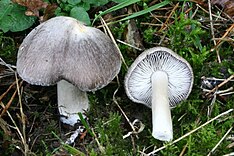Tricholoma terreum
| Tricholoma terreum | |
|---|---|
 |
|
| Scientific classification | |
| Kingdom: | Fungi |
| Division: | Basidiomycota |
| Class: | Agaricomycetes |
| Order: | Agaricales |
| Family: | Tricholomataceae |
| Genus: | Tricholoma |
| Species: | T. terreum |
| Binomial name | |
|
Tricholoma terreum (Schaeff.) P.Kumm. (1871) |
|
| Synonyms | |
|
|
| Tricholoma terreum | |
|---|---|
| Mycological characteristics | |
| gills on hymenium | |
|
|
cap is convex or flat |
| hymenium is adnexed | |
| stipe is bare | |
|
|
spore print is white to cream |
| ecology is mycorrhizal | |
| edibility: edible | |
cap is convex
spore print is white
Tricholoma terreum, commonly known as the grey knight or dirty tricholoma, is a grey-capped mushroom of the large genus Tricholoma. It is found in coniferous woodlands in Europe, and has also been encountered under introduced pine trees in Australia. It was historically regarded as edible, but in 2014, scientists discovered that it may be poisonous.
The fungus was originally described as Agaricus terreus by Jacob Christian Schäffer in 1762, and as Agaricus myomyces by mycologist Christian Hendrik Persoon in 1794. It was given its current binomial name by German Paul Kummer in 1871. It is commonly known as the grey knight from its discoloured gills. According to some European mycologists, Tricholoma myomyces is a synonym, but this is not universally accepted.
The cap is 4–7 cm (1.6–2.6 in) wide and evenly covered in fine grey scales. Convex with a slight boss, it is broadly conical in shape. The whitish stipe is 3–8 cm (1.2–3.2 in) high and 1.5 cm wide and has no ring. There is no ring or volva. The whitish flesh is thin, easily broken, and has a pleasant mild (not mealy) smell and taste. The widely spaced and uneven gills are free (unattached to the stipe). The spore print is white, the oval spores 6–7 μm long by 3.5-4.4 μm wide.
It could be confused with the larger (and poisonous) T. pardinum has a mealy smell and cap scales; the edible T. orirubens has fine dark scales and pinkish gills.
...
Wikipedia
